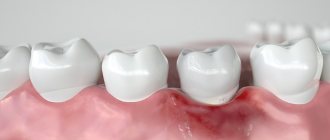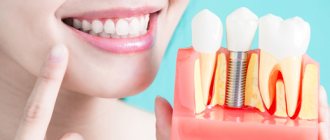What does pain depend on?
How long does the pain last? Localization of pain Pain during implantation Pain during prosthetics How to reduce pain? When to urgently consult a doctor? What to do if your jaw and gums hurt after dental implantation? Is this considered normal and how long can it last? Do I have to endure it? Let's look at it in more detail in our article.
During the implantation of a titanium rod into the bone, a puncture is made in the gums, and tissues and blood vessels are consequently injured, so pain, swelling or slight bleeding is a normal response of the body.
The implantation itself takes place without pain, since the procedure for installing an artificial tooth root is carried out under anesthesia. After its effect ends, sensitivity returns, an aching, throbbing pain syndrome appears, it should go away on the 10th day or earlier.
What does pain depend on during rehabilitation, on what days what sensations should be felt?
Pain after implantation begins when the anesthetic effect of the anesthetic drug ends. After 1.5-2 hours
.
Some tissue numbness may also be present. After 5-7 hours
, if normal sensitivity does not appear, you should consult a doctor, because There is a risk of damage to the facial nerve. Severe pain after dental implantation in the lower jaw can also be caused by trauma to the trigeminal nerve, because it is in close proximity to the roots.
The severity and degree of pain depends on:
- depending on the number of implants installed: one or several;
- depending on the type of operation: for implantation, the gum tissue was cut, followed by sutures - patchwork method (in rare cases) or a puncture was made (transgingival method);
- on the individual characteristics of the patient’s body, his pain threshold;
- from additional surgical interventions: sinus lifting, bone tissue augmentation, etc.
Causes of peri-implantitis
The causes of peri-implantitis may be the following:
- Insufficient diagnosis of diseases of the patient’s body;
- Wrong choice of implantation technique and type of implants;
- Failure to comply with sterility and aseptic rules during surgery;
- Inaccurate installation of structures;
- Fixation of an unsuitable abutment;
- Use of low-quality materials;
- Insufficient or poor-quality hygienic care for the oral cavity;
- Failure to comply with doctor's recommendations;
- Early loading of the structure;
- Exacerbation of chronic diseases of the body;
- Bad smoking habits and alcohol abuse.
How long does pain last after dental implant placement?
Let's consider the normal postoperative course of the condition.
1-5 day
. The pain may increase during the first few days, starting from the moment the anesthetic administered before implantation wears off. It can be aching, throbbing, and worsened by tilting the head. While this does not indicate a complication, this is the body’s natural response to intervention. As well as swelling of the tissues in the area of the implant.
5-10 day
. By the 5th day the pain subsides. The swelling subsides completely. The question remains for the patient: how much does the gum hurt after installing the implant, since it is still sensitive. By the 10th day, as a rule, everything goes away.
After 2-6 months
. There are times when everything goes fine, but after a few months or even a year a person complains that the tooth implant around it hurts. Possible reasons:
- loosening
of the plug, adaptation crown on the abutment. They rub the soft gum tissue. The situation is not critical. The dentist will adjust, carry out the necessary manipulations and you don’t have to worry about the safety of the implant;
implant rejection An unfavorable outcome of the entire implantation is unsuccessful osseointegration. The body did not accept the artificial tooth root. Fortunately, the rejection rate is close to 1%;- inflammatory
gum diseases. This is often due to poor hygiene and violation of the doctor’s postoperative recommendations; - injury
to the jaw nerve, then the jaw hurts after implantation.
If your gums, jaw, or ear hurt for more than 10 days after dental implantation, do not put off visiting the doctor who performed the operation. Early diagnosis and initiation of treatment will avoid complications. Calling after two weeks or more with such symptoms may delay treatment for a longer period.
If the implant hurts after a year
Dentists rarely encounter unusual situations when toothache in the implant area occurs only a year after the intervention. Then we are talking about long-term negative consequences of previous treatment, such as:
- Peri-implantitis . Inflammation occurs along the perimeter of the implanted titanium pin. The problem arises if the doctor violated the basic rules of prosthetics or if the patient did not pay due attention to dental care. The infection affects hard and soft tissues and leads to bone resorption. If timely treatment is not carried out, the dental implant will be rejected.
- Rejection of a titanium pin. This doesn't happen often. The fact that the body is rejecting the implant can be understood by the following signs: increased body temperature, swelling in the area of the artificial tooth, loosening and mobility of the prosthesis, separation of pus from the gums.
Both described reasons require urgent receipt of qualified dental care. These are not situations where you can delay treatment.
Pain depending on location and specificity, what does it mean?
Unpleasant sensations can be of a different nature, as well as their location.
- Pulsation at the implantation site, tingling, itching can be either normal or a sign of an allergic reaction to the material. You should continue to take antihistamines (as agreed with your doctor) and monitor the course of such manifestations;
- The unit located next to the installed artificial root is alarming. This may indicate nerve damage, gum inflammation or unsuccessful implantation, or it is possible that the crown is pressing, so the adjacent tooth hurts after the implant is installed;
- Severe pain in the ear after dental implantation in the lower jaw, which does not go away within a week, may indicate a violation of the integrity of the trigeminal nerve. The cause may be an incorrectly installed implant or injury from an instrument when preparing the bed;
- The answer to the question of why and how much gum pain after implant installation depends on the person’s health. Normally, the gums may ache for 5-7 days
. By the day the sutures are removed, usually on the 7th day, the pain goes away; - Bursting pain near the implant, the appearance of pus with light pressure, and temperature may indicate an inflammatory process. The main thing is to prevent the infection from joining. You should immediately consult a doctor.
Treatment of complications
Periostitis is treated using two methods:
- The conservative method involves anesthesia, cleansing the area around the structure, removing granulations and sanitation of the affected area. In this case, the abutment is removed and then installed in place. During therapy, the patient takes antibacterial drugs;
- The surgical method is based on removing the implant at the first signs of the disease. Next, the bone bed is sanitized, granulations are cleaned, copious treatment with antiseptics, and inflammation is eliminated. After treatment, the implant is installed in its original place.
To the list of posts
Pain during implantation, is it painful to install an implant?
For those who were once familiar with the removal of eights (wisdom teeth), they know how unpleasant it is. Implantation is a completely painless operation. The anesthesia is enough to make everything comfortable. The patient feels manipulation in the oral cavity, but there is no pain. Even the injection itself with an anesthetic solution can be made invisible. After treating the puncture site with special means.
There are several types of anesthesia for implantation:
- local
, used in most cases.
It is quite enough for work. An injection is given and within a few minutes the medicine begins to act. Installation of one implant takes 15-30 minutes
, and the effect of anesthesia ends after a few hours; - sedation
_ The patient is half asleep, there are no unpleasant sensations, but there may be consequences; - anesthesia
_ To undergo implantation under anesthesia, you will need to undergo certain tests and consult an anesthesiologist. Coming out of anesthesia takes time. This method is used very rarely, it is not available in all clinics and can be dangerous.
Why does a tooth hurt after implantation - the most common reasons
Discomfort after distal rod placement can manifest itself in a variety of ways. Most often it is dull and aching in nature, reminiscent of those unpleasant sensations that persist for some time after tooth extraction. Some people complain of severe itching in the injured gum area.
It is important to be alert if it seems that the soft tissues are pulsating, there is a pronounced feeling of their distension. It is especially dangerous if the painful symptoms are radiating, that is, they spread to other parts of the oral cavity.
How to Reduce or Prevent Pain During Recovery, Do's and Don'ts
In the postoperative period, the main thing is to strictly follow all the doctor’s recommendations. Basic:
- in the first hours after implantation, do not eat or drink;
- the first days (about a week) eat liquid foods: soups, purees, baby food;
- exclude hot, cold, spicy, alcohol;
- After surgery, apply cold compresses to relieve swelling;
- take prescribed medications strictly according to the schedule. Do not cancel them yourself if you feel better;
- make mouth baths using antiseptics: chlorhexidine, chamomile;
- sleep on a high pillow and on the opposite operating side;
- forget about physical activity for a while;
- Going to bathhouses and saunas is prohibited.
Usually, every dental clinic has a reminder about what is possible after implantation, what is prohibited, how to relieve pain after dental implantation, and a schedule for visiting the doctor.
The doctor will definitely prescribe painkillers - Nurofen, Nimesil, Analgin, Nise, etc. They need to be taken as long as the pain lasts after installing the dental implant, up to 7-10 days. If it persists longer, it is better to contact your dentist.
How to get rid of pain
Methods for eliminating pain can be different - it all depends on the diagnosis and the cause of the problem. To create an effective therapeutic regimen. The doctor conducts an examination and takes pictures. When the situation becomes clearer, the patient may be offered one of the following treatment options:
- Carrying out professional oral hygiene, taking anti-inflammatory drugs, antibiotics.
- Carrying out therapeutic rinses using antiseptics and anti-inflammatory solutions. Treatment of the affected area with wound-healing gels and ointments.
- Applying compresses to the inflamed area.
- Taking painkillers based on paracetamol, nimesulide, ketorolac.
- Carrying out sinus lift surgery. It is needed if the maxillary sinus was accidentally damaged during implantation.
If the inflammation is very severe, the pin is rejected, and surgery to remove it may be required. Subsequently, when the gums have healed, the patient is offered another prosthetic option or the implant is re-installed.
What if the implant gets sick long after surgery?
Peri-implantitis is insidious; it can occur unnoticed. After some time, there will be a sharp or bursting pain, radiating even to the nose, ear, head, face. This indicates inflammation of the tissue around the artificial root. Complaint: the tooth implant hurts; it is incorrect in this case. After all, the implant itself cannot hurt; it is a non-living structure, but the soft tissue around it can. The main thing is not to wait as long as you are willing to endure, but to go to the clinic urgently.
Peri-imlantitis on x-ray
The body is not always ready to accept a foreign object and osseointegrate with it. Rejection is extremely rare - less than 1.5% of cases. But you must always monitor your well-being.
Stages of pathology
The disease develops gradually and has several stages:
- At the first stage, the integrity of the bone tissue is preserved, but the gums become thinner and gum pockets form. The mucous membrane around the product is hyperemic, edematous and periodically bleeds;
- At the second stage, the soft tissues become loose, atrophy even more, and peel off from the implant. Gum pockets expand, the tooth becomes mobile;
- The third stage is characterized by pain, significant mobility of the structure, and the abutment becomes exposed. Pain occurs when biting on the crown, it becomes impossible to eat;
- At the fourth stage, complete destruction of the alveolar bone is observed, the implant is visible through the gum and is practically not fixed in the jaw. The patient is worried about acute pain, inflammation of tissues, and a violation of the general condition.
Memo for patients after implantation
There are fairly simple rules that reduce the likelihood of postoperative complications. Anyone planning to install an implant should know about them:
- In the first few days, pain is normal. If it is very strong, you need to take painkillers prescribed by your doctor.
- In the first week after surgery, it is important to avoid overheating and hypothermia.
- From the first to the seventh day after implantation, you should eat only soft and liquid foods. It should not be too cold or hot.
- For the speedy healing of gums, you need to maintain oral hygiene. It is better to use a new brush with soft bristles. Do not rub in the implantation area.
- It is forbidden to rinse your mouth vigorously. For speedy healing, doctors recommend so-called oral baths. During them, the patient takes an anti-inflammatory solution into the cheek and calmly holds it for several minutes. Then he spits and repeats the procedure from the beginning.
- In order to recognize complications in time, in the first week after dental surgery you need to measure your body temperature in the morning and evening.
- Do not smoke for two weeks after implantation.
People who take a responsible approach to the rehabilitation period are much less likely to encounter postoperative complications.
When is a temporary crown placed on a screw-mounted implant?
A one-stage implantation method is when, after the implantation operation, a temporary crown is immediately placed. If the mechanical stability of the titanium root is good, temporary crowns remain until the implant has completely fused with the jaw bone tissue.
I usually recommend the one-stage prosthetic method to the patient if restoration of the dentition in the smile area is required. The design of this type of implantation is one-piece; the abutment (the connecting link between the crown and the root) is already fixed. The crown is attached to the implant with a screw. The screw connection to the jawbone allows you to withstand chewing loads immediately after surgery.
For the restoration of chewing teeth, it is advisable to use the classic two-stage implantation method. Only with delayed installation of the crown can strong fixation of the titanium “root” be guaranteed.
The implantation stage is carried out by an implant surgeon.
How to care for implant crowns
The postoperative period is an important moment to ensure the implant’s reliability and longevity. A few simple recommendations will allow you to properly care for temporary crowns:
- Complete refusal to take solid foods: apples, pears, crackers, seeds, nuts, hard candies, etc.
- Try not to put stress on the area where the implant is installed.
- Brush your teeth with a soft brush, avoiding strong pressure on the crown.
- It’s better to give up dental floss for now and use an irrigator. Water massage increases blood circulation, thereby accelerating the process of restoration of soft gum tissue.
Regular visits to the doctor will eliminate possible problems in the future: the crown on the implant is pressing or loose.
When to place a crown on an installed implant
Dental implantation is a long and complex process, but at the same time better quality in comparison with traditional prosthetic methods. Prosthetics of this type includes two main stages:
- Diagnostics, preparation and implantation.
- Placement of the crown on the implant and fixation of the abutment.
Already at the first stage, depending on the results obtained, I can accurately inform the patient about the method of installing the implant and how long it will take to place a permanent crown on the implant.
The timing of fusion of a tooth implant with bone tissue is strictly individual. And the waiting time can vary from four months to six months. It will take about another month for the gums to form around the artificial tooth. Only after this will the crown be made and placed.
But there are also cases when a crown can be placed immediately after implantation. This is the so-called one-stage implantation - one-stage prosthetics.











